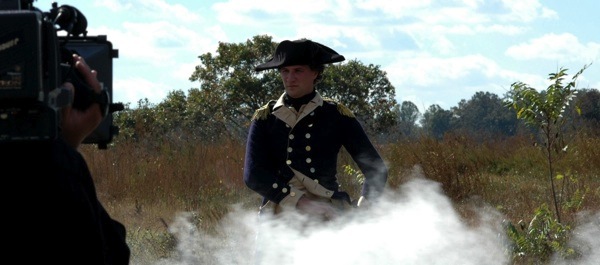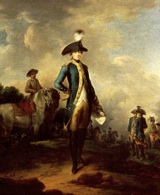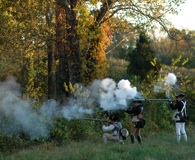
In Lafayette: The Lost Hero, a biography from WETA that premieres Monday, September 13, at 10:00 (EDT) on PBS, the narrator makes the statement early on: “France and America have always had a strange love-hate relationship.” The program goes on to give several valid examples of this. While it’s true we Americans have had issues with the French for centuries—their perceived arrogance, their politics—it is entirely possible there would not be a United States of America without the efforts, passion and determination of one Frenchman, the Marquis de Lafayette.
The Marquis was certainly not a lost hero in this country’s early days. His importance, when he arrived at the height of the Revolutionary War and became a key player in the military success of the Continental Army, continued to soar right up to the final major battle and ultimate capitulation of the British. He was as close as any man to George Washington and befriended Thomas Jefferson, Benjamin Franklin and many more among the nation’s early leaders. Fifty years after the end of the Revolution, when President James Monroe invited him stateside for an extended visit, he continued to receive praise and thanks from renowned leaders and common Americans. If his stature has lost something over time, it may be because folks here don’t always perceive foreign heroes in the same way they perceive the many heroic Americans in our history.
In a refreshingly different kind of television biography, documentarian Oren Jacoby and his team set out to remind us what a fascinating person Lafayette was. Born into an aristocratic family with a 700-year warrior tradition, Lafayette might be expected to be content with the family’s money, prestige and royal connections.
But he was not. He was two when his father was killed at the Battle of Minden during the Seven Years War, and the boy was baptized with multiple saints’ names to protect him from the same fate. (His full name is Marie Joseph Paul Yves Roch Gilbert du Motier, Marquis de Lafayette.)
 He much preferred the open countryside of his youth to the stuffy confines of Paris and Versailles where his mother associated with the king’s court. Receiving the family fortune upon her death, Lafayette fell in love, cleverly toyed with the French royal family and cast a plan to make his own way in the world. All of these things would affect him for the bulk of his life.
He much preferred the open countryside of his youth to the stuffy confines of Paris and Versailles where his mother associated with the king’s court. Receiving the family fortune upon her death, Lafayette fell in love, cleverly toyed with the French royal family and cast a plan to make his own way in the world. All of these things would affect him for the bulk of his life.
Lafayette was a warrior, and war at the time was in America. So, in 1777 he bought a ship and a tiny army of supporters and made a long and dangerous journey to South Carolina, then marched through British forces north to Philadelphia. In doing this, he angered the French king and abandoned (though only physically), his young, pregnant wife, Adrienne. Within the documentary, he goes right up to the front door of Independence Hall and knocks, only to be turned away immediately by a government fed up with receiving would-be French officers plying their services, but the government recants the next day. The truth is a bit more complex, involving the Marquis’s initial expectation of high rank and his later offer to serve without pay.
Leading a small command at the Battle of Brandywine, September 11, 1777, he was wounded in the leg but recovered quickly. Given command of a division shortly after his 20th birthday, he went on to earn the trust and admiration of George Washington, particularly through the long, hard winter of 1777–78 at Valley Forge.
These experiences and those that lay ahead in Lafayette’s long life are told in a story that unravels through unique scenarios in the program. It’s as if Jacoby went shopping in the mall of documentary techniques and put one of each in his basket. In Lafayette: The Lost Hero Jacoby bends and twists through different techniques to glide easily through the biography and make it entertaining. He shows a map with all the places named Lafayette in the U. S. A. and takes us to some of them; he uses clips from several Lafayette movies, etc.
 The all-important first five minutes had me hooked as Revolutionary War reenactors arrive on a benign landscape to stage a scene for the documentary. The often folksy-sounding narrator reminds us that living history interpreters do so to try to understand how life was in times past. I concur and have been broadcasting that message for more than two decades, since I began filming authentic historical reenactments with the 200th anniversary Yorktown Victory Celebration. Jacoby’s opening scene hooked me, and I was delighted that the style and content held my attention to the end.
The all-important first five minutes had me hooked as Revolutionary War reenactors arrive on a benign landscape to stage a scene for the documentary. The often folksy-sounding narrator reminds us that living history interpreters do so to try to understand how life was in times past. I concur and have been broadcasting that message for more than two decades, since I began filming authentic historical reenactments with the 200th anniversary Yorktown Victory Celebration. Jacoby’s opening scene hooked me, and I was delighted that the style and content held my attention to the end.
Besides negotiating French arms, men and warships for the American war effort and leading a significant command at the Battle of Yorktown, Lafayette impressed the new nation in other ways. His love of liberty that brought him to the American cause extended in his mind to all citizens, and he encouraged the young nation to rid itself of the hypocritical scourge of slavery. He even bought the freedom of an African-American who acted as a military spy in his Yorktown command. Many of Lafayette’s feelings and thoughts are revealed in excerpts from his memoirs, convincingly delivered in the show in a gently accented voice.
James R. Gaines, a Lafayette biographer, picks up much of the weight of the narrative early in the program. With Sabine Renault-Sabloniere, another biographer and Lafayette descendent, the audience is led through the Marquis’ early life, long association with America, his uncomfortable and ultimately tragic role in the French revolution and the love bond he shared with his wife. Hearing her words are also among the more poignant moments in the program.
Although I enjoyed most of the cornucopia of techniques used in the program, the animated maps were a little creepy—literally; instead of animated arrows, color blobs creep down the maps. And when Mme. Renault-Sabloniere comes to the U. S. to visit that iconic symbol of French-American friendship, the Statue of Liberty, she is interviewed by Public Radio’s Sarah Vowell. Vowell’s dull-headed conversation with Lafayette’s 6-times great-granddaughter could definitely be used as evidence in a French snob’s derision of Americans. Garrison Keillor would have been better. These are minor aberrations, however, in a really engaging program about a remarkable man whom modern Americans have known precious little about.
Jay Wertz is the producer-director-writer of the award-winning 13-part documentary series Smithsonian’s Great Battles of the Civil War for The Learning Channel and Time-Life Video. He is also the author of The Native American Experience and The Civil War Experience 1861-1865 and co-authored Smithsonian’s Great Battles and Battlefields of the Civil War with prominent historian Edwin C. Bearss.




